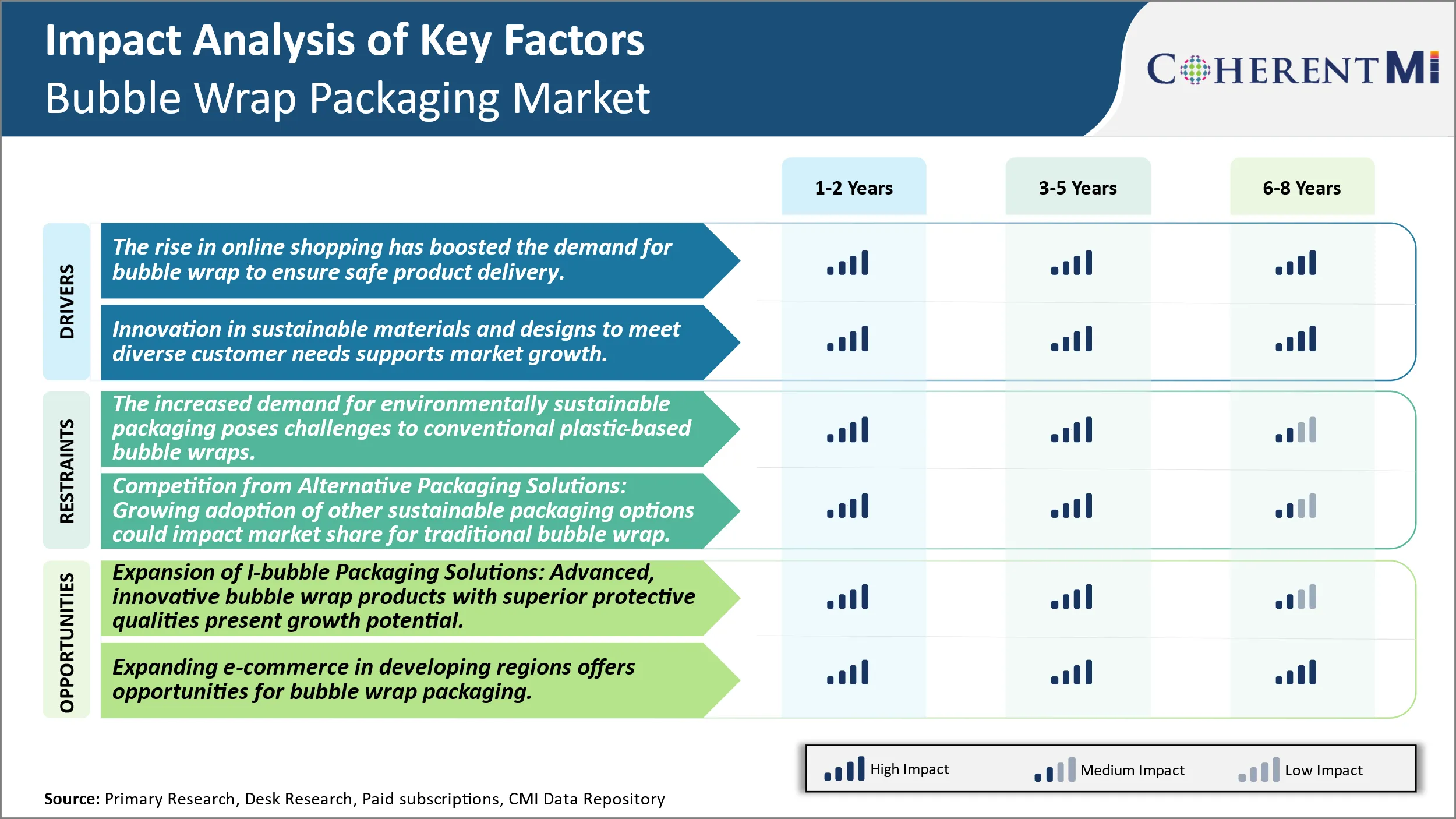Bubble Wrap Packaging Market Trends
Market Driver - The Rise in Online Shopping Has Boosted the Demand for Bubble Wrap to Ensure Safe Product Delivery
The rise of online shopping in the past decade has been one of the defining trends across major economies worldwide. As customers increasingly choose the convenience of shopping from the comfort of their homes, the need to deliver products safely to their doorsteps has assumed greater importance. This is where bubble wrap plays a crucial protective role. Whether it be appliances, furniture, home décor items, electronics or any other product that needs to be shipped, bubble wrap is widely used as the packing material of choice by both retailers and logistics companies.
The expansion of retail chains and emergence of diverse e-tail platforms in recent years has translated to exponential growth in the volume of shipments taking place. Customers now expect a variety of goods to be delivered within stringent timelines, which presents challenges in ensuring the items reach undamaged. Bubble wrap has proved extremely effective in cushioning products and preventing breakage due to impact during transportation. Its lightweight yet durable construction allows for multiple protective layers to be added based on the item's fragility. Furthermore, bubble wrap is cost-effective compared to alternatives and can be easily disposed offs after single use, aligning well with the fast-moving nature of online commerce.
The boost in e-commerce penetration driven by rising internet and smartphone adoption has majorly contributed to increased bubble wrap consumption. Whether within urban areas through mobile apps or in remote locales through web interfaces, online shopping portals have proliferated across regions. The 'try-it-at-home' model replacing showroom visits has expanded the market for various goods that now need protection packaging. Even traditional brick-and-mortar chains are augmenting their presence through their own websites and marketplaces to cater to evolving consumer preferences for digital browsing and purchasing. All of these dynamics are expected to sustain the upward bubble wrap demand trend in support of safe product deliveries.
Market Driver - Technological Advances in Bubble Wrap Materials Boosts Industry Development
Packaging manufacturers have consistently strived to innovate bubble wrap offerings to align with market developments as well as sustainability priorities. While the basic function of providing a lightweight cushion remains unchanged, materials and designs are undergoing upgrades. For instance, newer films are being developed from renewable post-consumer recycled plastic to reduce the carbon footprint. Similarly, biodegradable cellulose film options are gaining attention from companies targeting a 'green' image. Adjustable bubble sizes and arrangements can optimize protection based on each application too.
The growth of fragile and high-value product categories has driven interest in enhanced performance bubble wraps. Options with extra strong seals, moisture-proof barriers and anti-static properties for electronics are available. Bubble patterns are customized using digital printing to add visual appeal for promotional use as well gift wraps. Dual-layer wraps with extra sturdy internal screens allow reuse of the material multiple times, supporting cost-efficiency. Even automated packaging machinery integrates specialized film dispensers and sealers for precision and speed.
By addressing issues of waste management and versatility for diverse needs, advanced bubble films have expanded usage beyond traditional packaging. Their use in shipping hazardous goods, insulation, aquatic floatation devices, medical padding and crafts shows the wide reach. Continuous R&D will likely further widen such innovative applications. Overall, technology-led opportunities for optimized, sustainable and design-oriented bubble wraps are catalysts for market growth.

Market Challenge - The Increased Demand for Environmentally Sustainable Packaging Poses Challenges to Conventional Plastic-Based Bubble Wraps
The rising concerns over environmental sustainability has significantly increased the demand for eco-friendly packaging solutions from both businesses and consumers. Conventional plastic bubble wraps, which contain non-recyclable materials and result in massive plastic waste, do not align with this demand. Their production and disposal have considerable negative impacts on the environment through greenhouse gas emissions and plastic pollution. Growing regulations on single-use plastics in many countries also pose operational and compliance challenges for companies manufacturing traditional plastic bubble wraps. Identifying suitable biodegradable, recyclable and sustainable alternatives to plastic film and developing processes to collect and recycle used bubble wraps add to the production complexities and costs for suppliers. While plastic bubble wraps still dominate the market due to their excellent cushioning and protective properties, shifting consumer preferences and regulatory push towards sustainable options pressure wrap manufacturers to invest in green product innovation.
Market Opportunity: Advanced, Innovative Bubble Wrap Products with Superior Protective Qualities Present Growth Potential
The rising market challenges from environmental sustainability have created new opportunities for growth through innovative packaging solutions. Companies developing advanced bubble wrap products made of renewable and recyclable materials like paper and plant-based films are poised for expansion. In particular, ‘i-bubble’ technology which uses bubble-forming air columns trapped between two sheets without using plastic film has emerged as a breakthrough sustainable packaging format. I-bubble wraps offer cushioning performance comparable to conventional plastic variants while eliminating the usage of single-use plastics. Their recyclable paper-based construction aligns well with the increasing eco-consciousness among both businesses and consumers. As companies continue to improve i-bubble production processes and offerings, their superior protective qualities and sustainable attributes are likely to appeal to a wide range of industries, driving higher market acceptability and demand. With strategic investments in R&D and manufacturing scale-up, i-bubble solution providers stand to capture a major share of the rapidly evolving bubble wrap packaging market.